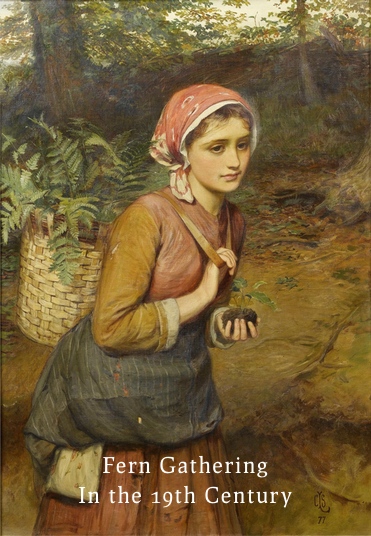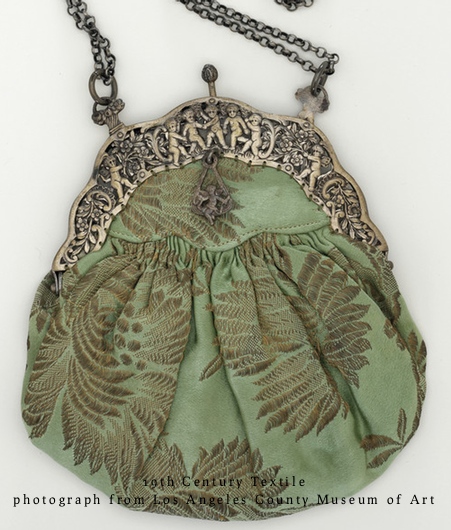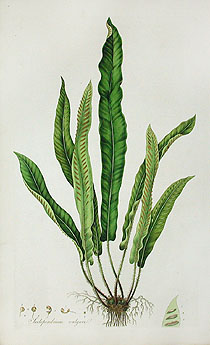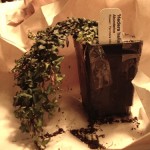Pteridomania – Love of Ferns
 It just seems that there is always something we humans find so utterly fascinating that we would do almost anything to possess one. This past Christmas, some families paid $1,500 for a toy that carried a retail price of around $50. In years past, we stood in lines, bribed shop clerks and even came to blows over that year’s hot toy. It was no different in years past. What was the hot, must have item in 19th century England? Ferns. Yes, you read that right; they were absolutely crazy about possessing ferns.
It just seems that there is always something we humans find so utterly fascinating that we would do almost anything to possess one. This past Christmas, some families paid $1,500 for a toy that carried a retail price of around $50. In years past, we stood in lines, bribed shop clerks and even came to blows over that year’s hot toy. It was no different in years past. What was the hot, must have item in 19th century England? Ferns. Yes, you read that right; they were absolutely crazy about possessing ferns.
Victorian Plant Collecting
Public gardens and public zoos were opening in greater numbers. The world’s first scientific zoo was established (1828) by the Zoological Society of London and opened to the public in 1847. But, maintaining your own collection of plant specimens was a true mark of status.
Victorians spent big money on collecting the most exotic plants and animals they could find. They knew the climate and air quality of London would be deadly to many of the more exotic specimens they coveted. The well-to-do began building indoor nurseries and glass buildings to house their collections. Orangeries housed the succulent orange fruits along with lemons, limes and other delicacies. Orchids were also highly sought after. However, for most of 19th century England, ferneries were the ultimate symbol of wealth and position.
Fern spores were traded and cultivated like baseball cards. In fact, there were even fern trading cards. Albums of pressed fern fronds were great treasures shown off to visitors. Instead of showing pictures/daguerreotypes of the latest grandchild, they had brag books of preserved ferns.
Pteridomia
 Pteridomia (fern mania) swept across England and much of the globe. Fern craziness appears to have reached epic proportions in England where people truly became manic for all things fern. They covered the walls of their homes with fern wallpaper. Their decorative porcelain and dinnerware were adorned with fern designs. And, even some apparel was dedicated to their love of ferns. – check out this beautiful lady’s purse. The workmanship on the clasp is amazing. (It is an American piece, but, the Americans went koo-koo for ferns too.)
Pteridomia (fern mania) swept across England and much of the globe. Fern craziness appears to have reached epic proportions in England where people truly became manic for all things fern. They covered the walls of their homes with fern wallpaper. Their decorative porcelain and dinnerware were adorned with fern designs. And, even some apparel was dedicated to their love of ferns. – check out this beautiful lady’s purse. The workmanship on the clasp is amazing. (It is an American piece, but, the Americans went koo-koo for ferns too.)
Explore some of the more well-preserved cemeteries of the time and you’ll be bound to find fern fronds decorating many of the grave stones.
The term Pteridomia was thought to have been first used in 1855. English botantists had been long-fascinated with ferns. But, it wasn’t until Dr. Nathaniel Bagshaw Ward (1791-1868) effectively invented the first terrarium in 1829, that ferns could be maintained indoors.
One botanist and historian believes Dr. Ward and 2 of his friends began pteridomania in England. Dr. Ward continued his studies whilst his friends developed the market for live ferns and fern spores. And, glaziers quickly began making beautiful and elaborate Wardian cases to house the ferns.
How Crazy Did They Get?
Fern mania led to deaths, confrontations with warring Indians and a bit of romance too.
There’s anecdotal evidence of one young woman falling to her death whilst trying to climb a cliff in pursuit of ferns. While it was getting easier to travel, no doubt there were many amateur and professional botanists who lost their lives in pursuit of finding the perfect specimen.
A pair of American botanists, John Gill Lemmon and his wife Sara, purposely traveled into the heart of Apache country in search of plant specimens; including ferns. Despite knowing the Apache were actively killing settlers in the area, they made several expeditions. Sara Lemmon had written of Pacific coast ferns in 1881. In 1882, they were even captured and searched by an Apache band. Finding only plants in their packs, the Indians thought them harmless and let the crazy white people continue on their way.
Fern gathering parties became social events much like fox hunting. Participants would gather together to scour the countryside in search of native ferns. They became a great way for young people to escape the rules of society about proper behavior. No doubt many participants found more romance than fern fronds.
Pteridomania Consequences
So, in the end, what came of all the crazy fern maniacs and pteridomania? Some good and some very not good.
Fern Prints
One historian believes there were at least 240 books published on ferns and fern care during the 19th century. That doesn’t take into account the many other works which also discussed ferns. Interest was so high in these plants, that quite often these books included beautiful full-color plates of the various fern species being discussed. Fortunately, many of these books can still be found and are being scanned and shared around the world.
Fern Cultivars
The desire of new fern discoveries and fern cultivation led to quite a bit of confusion. The same species were often discovered and named by multiple people or botanical societies. But, the desire to have the most exotic fern led botanists to take Britain’s 70 native species and natural fern hybrids and turn them into thousands of hybrids. It’s thought that some treasured species were hybridized into as many as 300 more varieties.
 Hart’s-tongue fern was one that received a great deal of attention during pteridomania.
Hart’s-tongue fern was one that received a great deal of attention during pteridomania.
Hart’s-tongue was doubly interesting for collectors because of their simple, undivided fronds with elongated tongue-shaped leaves. The sori (spore capsules) are also unusual – they generally look like stripes on the back of the leaves, rather than the round shape found on most other fern species. (shown in brown on the botanical print)
The British Pteridological Society was formed in 1891. It continues it’s original goal of sharing information about ferns through a variety of publications, activities and their website – ebps.org.uk. While some claim that the Americans did not succumb to Pteridomania like the Britons did, the American Fern Society was formed around the same time in 1893. Gee, I think Americans might have been just as crazy about ferns. Sounds like you would have to be at least a little crazy to willingly travel into hostile territory and face down Apache warriors to gather plant specimens.
Over-Harvesting
Unfortunately, when such crazes occur, people often get foolish and greedy. Sadly, many fern species made popular during this time are quite rare and are among Europe’s most endangered species. Like so many creatures and plants that once roamed the earth; they are gone forever or only remembered in historical works.
Ferns in the 21st Century
Sadly, we are still over-collecting ferns. In my home state of North Carolina, the lovely native southern maidenhair fern is on the endangered species list. Ironically, they are available in gardening centers here. I recently purchased what I believe to be a southern maidenhair for my own tiny green gardens in nearby Asheville.
21st century gardeners are able to procure ferns of all shapes and sizes from local, regional and online vendors. I would strongly urge you to research any species you are interested in before purchasing; particularly if you hope to plant ferns in your garden. Most of the commercially available plants are not very cold tolerant. While many allow Boston ferns to simply die at the end of summer, we’ve found they can winter over nicely in our garage.
I’ve also come to find that ferns, when kept indoors, can be quite fussy things. A little dry and fronds die. A little too little light and fronds die. But, when you make them happy, they do put on quite a nice show. I just might be beginning to catch the pteridomania bug.












I DEFINITELY have the mania! Thank you so much for his article. I only have one small tattoo, and of course, it’s a maidenhair fern! I have many ferns and mosses (another love) on my property, and in my house.